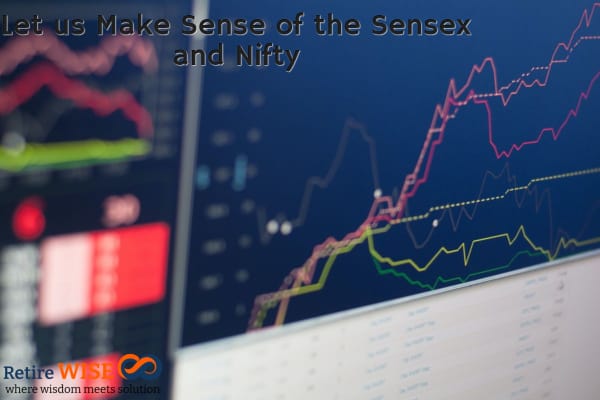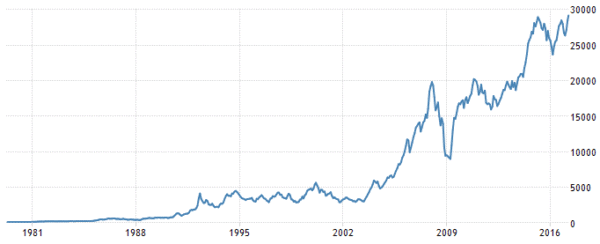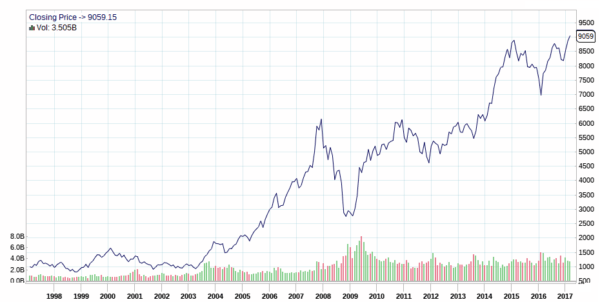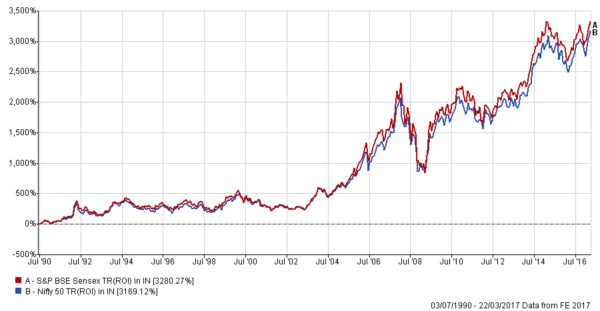You may not believe what I am going to share – you may think advisors know what is Sensex and Nifty but based on my interaction with top Mutual Fund advisors when I was in Job – most of them don’t have much clue. But I can assure you, after reading this post you will not have any doubt – I have covered
- What is Sensex and how it is calculated?
- What is Nifty and how it is calculated?
- Free float market capitalization
- Difference between Nifty and Sensex
- You can also check long term charts & performance

What is Sensex and Nifty?
What is Index? Definition of Index is “An Index is a statistical aggregate that measures change.” Remember this throughout this post – ‘statistical aggregate’. All Index are not the same – they can be differentiated based on countries, the market cap of stocks they cover, or even how any stock will become part of the Index. Sometimes I feel even the construction of an index is an art & not science 
Must Read – What is Equity?
What is Sensex?
Full-Form of Sensex is Sensitive Index. People are happy when the Sensex goes up and upset when it goes down. Sensex is the stock market index of the Bombay Stock Exchange or BSE – it is also called BSE Sensex.
Sensex Meaning
It is the market-weighted stock index of 30 companies that are selected on the basis of financial soundness and performance. Usually, large and well-established companies that are are representatives of the various industrial sectors are chosen.
Companies in Sensex India
| Adani Ports | Coal India | HUL | M&M | SBI |
| Asian Paints | Dr Reddys Labs | ICICI Bank | Maruti Suzuki | Sun Pharma |
| Axis Bank | GAIL | Infosys | NTPC | Tata Motors |
| Bajaj Auto | HDFC | ITC | ONGC | Tata Steel |
| Bharti Airtel | HDFC Bank | Larsen | Powergrid | TCS |
| Cipla | Hero Motocorp | Lupin | Reliance | Wipro |
Check – 8 Most important Mutual Fund Questions
It was first published in 1986. The base value of Sensex is 100 and the base year is 1978-79.
Let us look at some numbers.
- The number of stocks in the Sensex – 30
- As of March 15, 2017, the Full Market capitalization of Sensex is 4,986,299 crores and the free-float market capitalization is Rs. 2,687,777 crores
How has Sensex performed over the years?
Here is a graph that shows the value of Sensex since inception –

Nifty Chart – Historical Data
How Sensex is calculated?
The Sensex is calculated using the Free-float Market Capitalization’ method. In this method, the index reflects the free-float market value of the 30 constituent stocks relative to a base period.
What is meant by free-float market capitalization?
Free float stands for the shares that are open for trading. All shares may not be free-floating. Some may be pledged, some may be in the hands of the persons or bodies having controlling interest/promoters, some shares may be government holdings, etc. Such locked-in shares are not considered free-floating.
What is Market capitalization?
Market capitalization is the combined worth of all the stocks of different companies within the stock exchange.
The market capitalization of a company is arrived at by the product of the price of its stock and the number of shares issued by the company.
This figure is multiplied by the free-float factor to determine the free-float market capitalization. The free float factor is derived from the information each company submits regarding the free-floating shares. Every company has to give the information on a quarterly basis in a format given by BSE.
The free float market capitalization of all companies is summed up.
The free float market capitalisation is then divided by an index divisor to get the Sensex value. This divisor adjusts for changes in stocks and other corporate actions. The divisor is the value of the Sensex Index in the base year.
How Sensex Works – example
Suppose the index has two companies – X and Y.
Company X has 500 shares out of which 300 are free floating or available for the general public to buy and sell. The price of each share is Rs.80.
Company Y has 1000 shares out of which 700 are free-floating. The price of each share is Rs. 100
Market capital of Company X = 40000
Market capital of Company Y = 100000
Free-float factor for Company X = 0.60
Free-float factor for Company Y = 0.70
Total free float market capital of the index = (40000*0.60) + (100000*0.70) = 94000
Let us assume the base year index was 5000.
Value of Index = (94000 x 100)/5000 = 1880
So the Value of the Index is 1880.
The Same example can be applied to how nifty works.
Read – New Pension Scheme (NPS)
What are the Highs and Lows of Sensex in the last 10 years?
The market is affected by various political, social, and economic factors across the world. The lowest points were reached in 2008 when the stock markets in the U.S. started crashing and there were major credit losses in the U.S. There was a steep drop in 2015 as well.
The highest points were reached in August 2015 and in March 2017.
How can I use SENSEX to aide my investments?
- You can invest in Sensex-based funds to take advantage of the rising value.
- If the markets are volatile, the Sensex is swinging across different values, then it is better to wait for the volatility in the index to get less. (You were expecting this – better invest through SIP)
- The stocks in the SENSEX are financially sound. Most of them are blue-chip companies. You can invest in equity funds that invest in these shares.
- It serves as an indicator of how the economy is doing and how the companies are performing. This will help in prudent decision-making in your finances.
Check ETF & Index Funds
What is Nifty?
National Stock Exchange (NSE) is the leading stock exchange of India. Full form of NIFTY is “National Stock Exchange Fifty” – it is the broad index of NSE. NIFTY normally comprises of 50 stocks but right now there are 51 stocks. It is known as NIFTY 50 or CNX Nifty. It is owned and managed by India Index Services and Products Ltd. (IISL).
The base period for the Nifty index is November 3, 1995. The base value of the index has been set at 1000, and a base capital of Rs 2.06 trillion.
Check – Portfolio Management Services (PMS) in India
Which companies are part of the NIFTY 50?
There are certain eligibility criteria for companies that have to be met –
Liquidity – The stock should have traded at an average impact cost of 0.50 % or less during the last six months, for 90% of the observations for portfolio of Rs. 2 crores.
Float Adjustment – Companies must have at least twice the float-adjusted market capitalization of whatever is the current smallest index constituent.
Domicile – The company should be domiciled in India and trade on the NSE.
51 companies in NIFTY –
| ACC Ltd. | Bharti Airtel Ltd. | HDFC Bank Ltd. | Kotak Mahindra Bank | Sun Pharmaceutical Industries |
| Adani Ports | Bharti Infratel Ltd. | Hero MotoCorp Ltd. | Larsen & Toubro | Tata Consultancy Services |
| Ambuja Cements Ltd. | Bosch Ltd. AUTOMOBILE | Hindalco Industries Ltd. | Lupin Ltd. PHARMA | Tata Motors (DVR) |
| Asian Paints Ltd. | Cipla Ltd. PHARMA | Hindustan Unilever Ltd. | Mahindra & Mahindra | Tata Motors Ltd. |
| Aurobindo Pharma Ltd. | Coal India Ltd. | Housing Development Finance | Maruti Suzuki India | Tata Power Co. |
| Axis Bank Ltd. | Dr. Reddy’s Laboratories | ITC Ltd. | NTPC Ltd. ENERGY | Tata Steel Ltd. |
| Bajaj Auto Ltd. | Eicher Motors Ltd. | ICICI Bank Ltd. | ONGC | Tech Mahindra Ltd. |
| Bank of Baroda | GAIL (India) Ltd. | Idea Cellular Ltd. | Power Grid Corporation | UltraTech Cement Ltd. |
| Bharat Heavy Electricals | Grasim Industries Ltd. | IndusInd Bank Ltd. | Reliance Industries Ltd. | Wipro Ltd. IT |
| Bharat Petroleum Corporation | HCL Technologies Ltd. | Infosys Ltd. IT | State Bank of India | Yes Bank Ltd. |
| Zee Entertainment Enterprises |
The NIFTY 50 Index represents about 65% of the free-float market capitalization of these stocks listed on NSE Nifty as on March 31, 2016.
Check- ESOP in India
How has the NIFTY performed over the years?
Here is a graph that shows the value of NIFTY since inception –

Nifty Chart – Historical Data
How NIFTY is calculated?
NIFTY 50 is computed using free float market capitalization weighted method, wherein the level of the index reflects the total market value of all the stocks in the index relative to a particular base period
Here is the mathematical formula to arrive at the value of NIFTY –
Market Capitalization = Equity Capital x Price
Free Float Market Capitalization = Equity Capital x Price x IWF
Index Value = Current Market Value / Base Market Capital x Base Index Value (1000)
*IWF = Investible Weight Factor – It is a factor to determine the number of shares available for trading
The index is calculated in real-time daily whenever the value of any scrip changes.
What are the Highs and Lows of NIFTY in last 10 years?
The market is affected by various political, social, and economic factors across the world. The NIFTY fell more than 10% in one day during the sub-prime crisis in January 2008. It also fell by 490 points in August 2015 when the Chinese stock market crashed.
The highest points were reached in August 2015 and recently in March 2017.
The highest point of NIFTY is 9218.40 reached in March 2017
How can I use NIFTY to aide my investments?
- You can invest in NIFTY-based funds to get long-term benefits. It is a good place to invest as it is usually stable and is well-diversified.
- NIFTY ETFs or Index Funds can also be tried if you would like to stick with Index returns.
- Same as Sensex the stocks in the NIFTY are financially sound. Most of them are big blue-chip companies. You can invest in equity funds that invest in these shares.
What is SGX Nifty?
The full form of SGX Nifty is Singapore Nifty – it is just a derivative of CNX Nifty. In recent times it has gor prominace as it has more trading hours – trading starts before Indian Markets open & closes after that. So if there is major news & that may impact the market – people start looking or big investors start trading on SGX Nifty.
Must Check- 7 Types of Indian Investors, Which one are you?
Difference Between Sensex and Nifty
As such, there is no difference between Sensex and Nifty because both target large-cap stocks. There’s no difference in the performance – you can see that in 20 years chart.
NIFTY and Sensex are stock market indices that indicate the strength of the market. The NIFTY reflects the value of NSE and Sensex is the stock market index for BSE.

But if you still looking for a difference between Sensex and Nifty – NIFTY is more broad based as it has more listed securities (50 stocks) compared to Sensex (30 Stocks). NIFTY is considered to have a more diversified portfolio than Sensex. More trading happens in NSE as compared to in BSE.
Hope this article answers your questions on nifty and Sensex – if you still have any question feel free to add in the comment section.
There are numerous pundits who give buy/sell recommendations about various scripts. Could you please tell me where I can find a rating showing the accuracy of these so-called experts? Some of them are way off in their forecasts and appear to be giving their “tips” for dubious reasons.
informative and useful..lot of interesting info.
looking forward for more such articles
thank you so much
thanksfor sharing the sensex and nifty
usefull blog
can i invest in mutual funds without paying commissions?
Yes you can directly invest in MF but you have to pay asset management charges
Very interesting and insightful article. Thanks for sharing.
Hey, it is really informative, would like to know more.
Thanks Arif. What additional information you are looking for.
very helpfull article …….
Thanks Chaitanya
It’s a nice article Bt pls also explain about the decrement or increment in shares market. How the shares decreases or increases
Hi Prachi,
Let me give you a simple answer – which no one believes “Demand & Supply”. Market commentators will give you n number of reasons – you can pick any of them.
Thanks .
This article provides good initial information and definitions.
You have rightly placed that ETF stocks of Sensex and NIFTY are good for long term regular investment like SIP.
Kindly let me other performance parameters such expense ratio, cost of buy and cost of selling etc. for ETF of Sensex and NIFTY.
This information would help me to take an early decision on long term investment.
Regards,
Hi Shankar,
You should check this https://www.retirewise.in/dsp-blackrock-equal-nifty-50-fund-review/
Thanks, very well explained.
I was always keen to know what you have explained in your article. Really likes your articulation. Explained in a manner a naive user like me can understand. Thanks..
Thanks Farzana
The article was realy helpful..thank you
Thanks Mirshad
Very much helpful…bt can u plz let me know about the mutual funds and how it works.?
You should check https://www.retirewise.in/how-mutual-funds-work/
Thanks a lot.. for explaining these terms in such an easy ways.. it had really helped me
Thanks for appreciating our effort ?
Thanks for such a compact and effective explanation.
Thanks Arya – your comments motivate us to work harder ?
Good article
Thanks Chandan ji
Very nice article, simple and easily understandable. Liked the way you explained using calculation.
Thanks Shoeb
Very Nice Information……..Simply & Understandably
Thanks Sharvan
Thankss a lot for this sir…. ?
Gr8. Complex things made so simple. Requested to explain differences between different investment instruments like shares, bonds, debentures, debt instruments government ,securities,etcetera.
Thanks Sandeep.
You can subscribe to our newsletter – you will get such information on regular basis.
I’m not gotting what is share and sensex…
What is base year index?
I couldn’t understand this can u explain in detail
Hi Shivani,
Check this
https://www.retirewise.in/what-is-equity-understand-its-right-meaning-to-reap-the-benifit/
Thank you so much for this. Just one doubt though. In the example, why is the index not 18.80 but 1880? Why have you multiplied 94000 by 100 in the final step?
Thanks once again.
Is it to express it as a percentage?
Could u please tell me how we got the value of Base year index.
It’s a good source of knowledge about SENSEX & NIFTY with share markets.
Very much useful and informative.
Hey Hemant, I would like to know after what duration the selections of the top 50 & 30 companies listed on BSE & NSE take place. As these determine the sensex and nifty index
What are the timings of both of them?
Helpful article…….
Got a better understanding with the help of this article.
Thankyou
Thanks Vibhor.
Nice article but after reading this there is a doubt explain how to decrease or increase in the share price l could not understanding
Very useful & informative clarifications
Thanks Poonam
Greatly written and well explained ?
very useful guide
Thanks Ramnath
Thank you sir.
Very usefulness.
NICE ARTICLE
Thanks
I am new investor, please tell me how to invest in Nifty/Sensex ?
Hi Taran,
You can check ETF or Index funds – you can also consider simple diversified equity funds.
Thanks a lot Hemanth Sir… It’s a good article… Which clarified my doubts….
Hello, I think this is a fantastic and lucidly written article. However, I have a doubt. Why is the base year for sensex 1978-79 though it was established only much later, in 1986?
They did some reverse calculation
Very Useful
thank you mr hemanth for providing a detail explanation
Very useful article than you for sharing @HemantBeniwal ?
Thanks Deepali
Full form of NIFTY is National Index Fifty. It represents the weighted average of 50 Indian company stocks in 13 sectors and is one of the two main stock indices used in India, the other being the BSE Sensex. … The Nifty 50 was launched 1 April 1996, and is one of the many stock indices of Nifty.
Comments are closed.